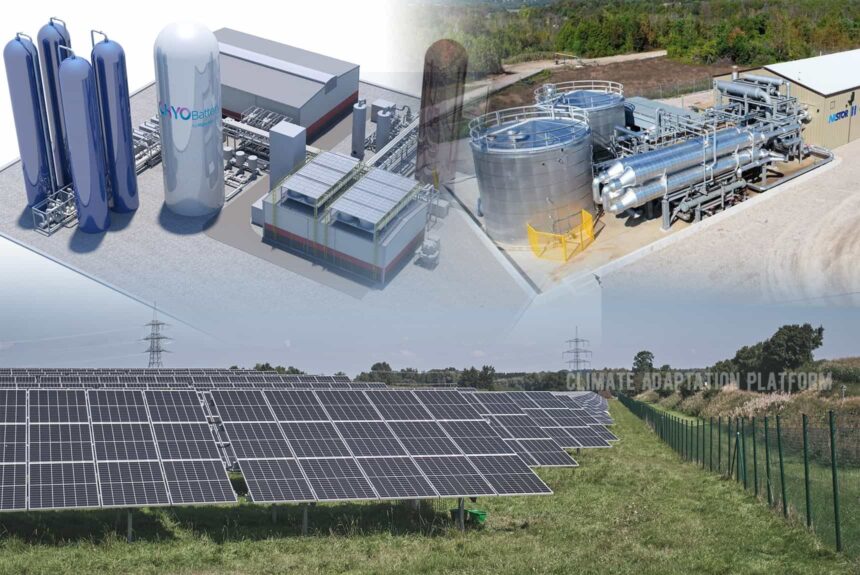Solving the climate crisis means getting rid of carbon dioxide, but what if carbon dioxide also becomes a solution to climate change?
Energy Dome, an Italian startup, has invented “CO2 batteries”, a type of long-duration energy storage (LDES), which store the gas under high pressure when renewable energy is plentiful. The gas is run through a turbine when electricity is needed to generate power.
The Economist article, “Decarbonisation of electric grids reliant on renewables requires long-duration energy storage”, presents the continuous innovation in long-duration energy storage (LDES). It explains the LDES’s crucial role in storing and providing clean power that could stretch for days and even weeks. This feat leads the power sector to achieve deep decarbonisation.
Godart van Gendt of McKinsey, who works in the field, says that “LDES allows you to go from 60-70% renewables on the grid to 100%.”
The article says that storage systems are measured in two ways – the amount of power they can deliver, expressed in multiples of watts, and the amount of energy they can store, said in a multiple of watt-hours.
CO2 batteries are mechanical energy storage that uses turbines and other machinery that could store renewable energy for up to many hours to many days. According to the article, CO2 batteries work like a hydropower plant – the world’s largest provider of LDES. “When electricity is cheap and copious, water is pumped up into a high-level reservoir. When electricity is scarce, the water is allowed to run back down to a lower level, spinning a turbine as it does so”.
Canary Media reports that the Italian startup Energy Dome promised to successfully demonstrate a novel technique for storing large amounts of clean power and use it to build a full-scale powerplant last year.
In early June this year, it made good on its promise when the company completed a 2.5-megawatt/4megawatt-hour unit in Sardinia (Spector, 2022). The company also announced that it closed an $11 million bridge funding round to buy equipment for a 20-megawatt/200-megawatt-hour facility for major Italian utility A2A (Spector, 2022).
CEO Claudio Spadacini told Canary Media2 they intend to proceed at high speed because climate change does not wait. ”The market needs a solution for [long-duration energy storage] that is quickly available, efficient and reliable,” she added.
Other types of LDES
Long-duration energy storage (LDEs) comes in four groups: Mechanical, electrochemical, thermal, and chemical.
Continuous improvements in battery technology result in better batteries in terms of the power they can store and deliver.
Advantages of Energy Dome’s CO2 batteries to other LDES
Canary Media lists the benefits of the Energy Dome’s LDES relative to others.
- It uses off-the-shelf equipment from mature industrial supply chains. That means Energy Dome doesn’t need to build its factory, a capital-intensive step that other long-duration startups need to do. It also means Energy Dome doesn’t need to spend years on laboratory science — it just needs to prove that the equipment works together the way it’s supposed to.
- The dome is supposed to deliver round-trip efficiency of 75 per cent, meaning 75 per cent of the energy that goes into the process comes back at the end. That’s less than typical battery efficiency but much better than many long-duration storage contenders.
- Carbon dioxide is easier to compress and store at ambient temperature and atmospheric pressure than other gaseous storage vehicles, like hydrogen or air.
The Canary Media article notes that the pilot plant has successfully put these theoretical advantages to the test and has been operating successfully in stand-alone testing mode. The company plans to deliver ancillary services to the national grid once testing is done.
As we strive toward a carbon-neutral economy by 2050, a future powered by clean energy can steer us away from the devastating impacts of climate change.
Still, due to the variable nature of renewable energy, batteries can smooth out the intermittencies that renewable generation can experience and enable the deployment of renewables at scale.
Long-duration energy storage that could provide days and even weeks of available energy is required to achieve deep power sector decarbonisation.
Policymakers consider supporting the evolution of long-duration, clean energy storage by encouraging technology innovation and enabling financing and procurement models that align with long-duration storage.
To know more about LDES, click the source links below:
Decarbonisation of electric grids reliant on renewables requires long-duration energy storage. (2020 June 24). The Economist. Retrieved https://www.economist.com/technology-quarterly/2022/06/23/decarbonisation-of-electric-grids-reliant-on-renewables-requires-long-duration-energy-storage
Spector, J. (2022, June 28). Energy Dome is on the brink of a long-duration storage breakthrough. Canary Media. Retrieved from https://www.canarymedia.com/articles/long-duration-energy-storage/energy-dome-is-on-the-brink-of-a-long-duration-storage-breakthrough
BACKGROUND IMAGE CREDIT:



Leave a Reply